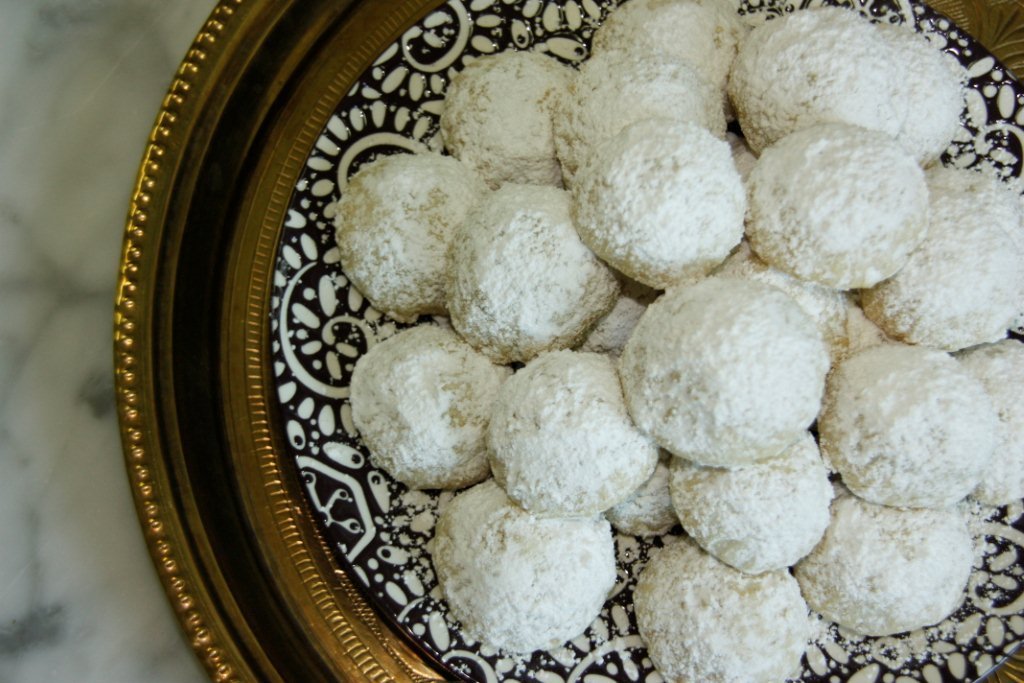
Eid after Eid I’ve been making date-filled ma’amoul pastry, thinking the nut-filled pastry would too tricky. I imagined the nuts spilling all over and the pastries falling apart. So, I stuck with date filling.
Now I know better. The nut-filled ma’amoul are not only exquisite, but to my amazement, they are easier. No spills or falling apart. Think of time I could have saved! And all the pistachio-filled pastries I could have enjoyed!
Compared to the date-filled ma’amoul, the nut-filled ones are a breeze. It takes minutes to chop the nuts and mix them with some sugar and flavorings. Meanwhile, it takes hours to pit and shape the date ball fillers. If only I had known!
At Bit of Background
Ma’amoul are delicate little stuffed pastries that are served all over the Arab world for Eid and Easter. They have several fillings—dates, walnuts or pistachios—and they come in a variety of shapes. Sometimes they are made with semolina, sometimes flour. Last Eid I posted my recipe for date-filled ma’amoul.
I use a special wooden mold to shape my ma’amoul. I’ve noticed that the round shallow molds are for dates, while oval molds are for pistachios and deeper molds are for walnuts. Of course, if you don’t have all these shapes, just make do with what you have. If you don’t have any mold at all—no problem. You can shape the ma’amoul in your hand with the tines of a fork.
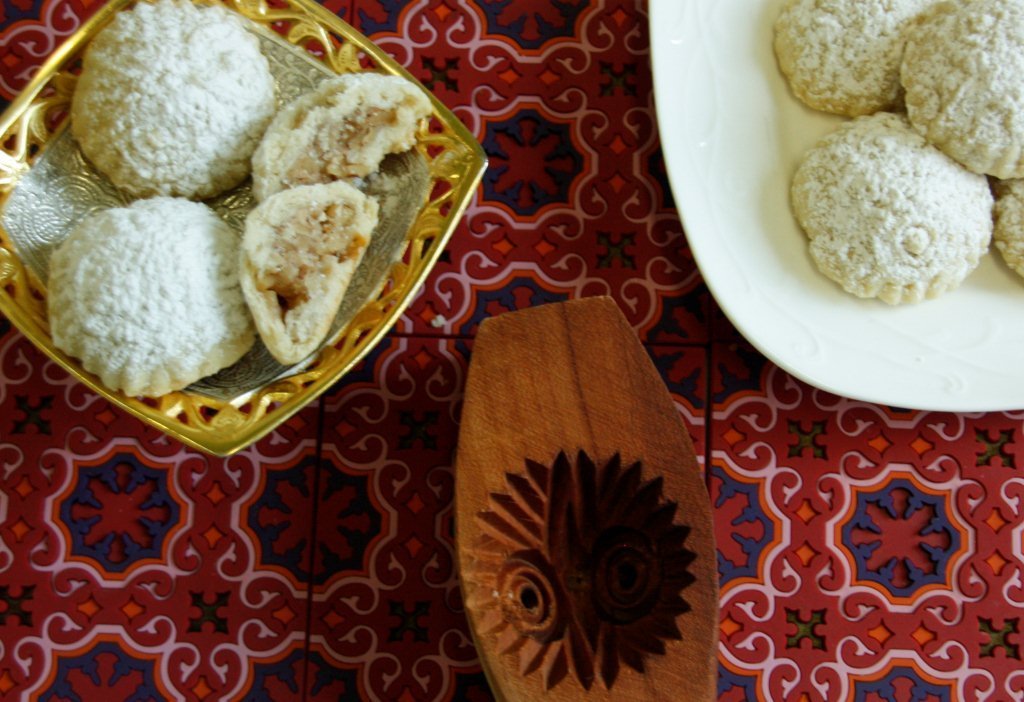
For the nut fillings below, you can use either granulated (caster) sugar or powdered sugar. The powdered sugar is less grainy. It’s all a matter of preference. The recipe below calls for rosewater, but orange blossom water can also be used. I suggest making both nut fillings, but you may have some nuts left over depending on the size of your pastries.
MA’AMOUL
Makes about 36 pastries (depending on the size of the mold)
Pastry Ingredients:
2½ c flour
½ lb. (two sticks or 200 g) unsalted butter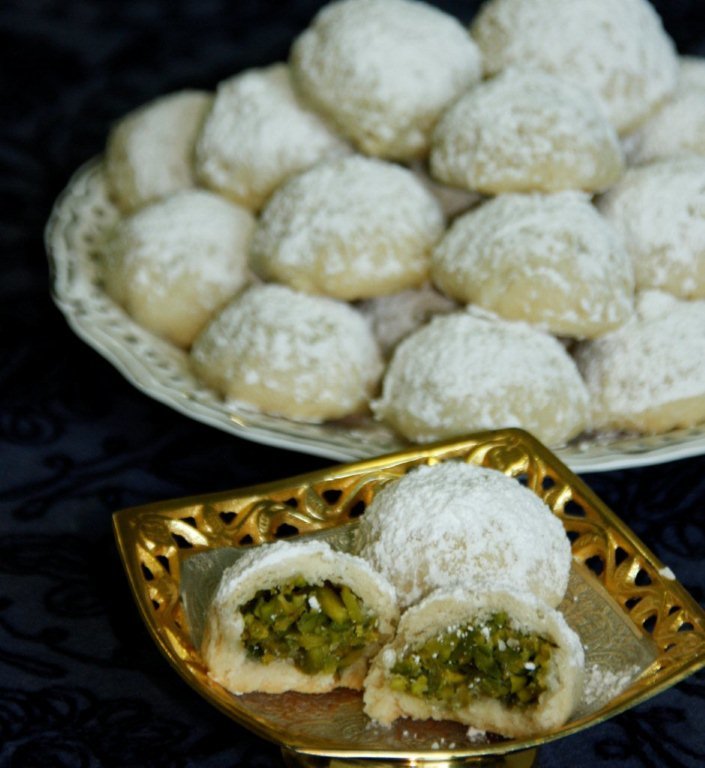
1 Tablespoon rosewater
4 Tablespoons milk
Sifted confectioner’s sugar for dusting the pastries
Pistachio Filling
1 cup chopped pistachio
½ cup sugar (granulated or powdered)
1 Tablespoon rosewater
Walnut Filling
1 cup chopped nuts
½ cup sugar (granulated or powdered)
½ teaspoon cinnamon
1 Tablespoon rosewater
Method
1. Make the two nut fillings. Chop the nuts and mix in the sugar. If you don’t like a grainy texture, you can use powdered sugar. The tablespoon of rosewater will make the nut mixture moist and easy to shape. Add cinnamon to the walnuts.
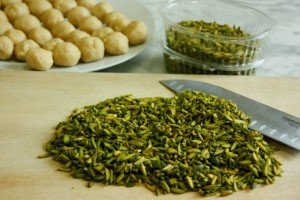
2. To prepare the dough, begin by sifting the flour into a large mixing bowl. Work the butter into the flour with your hands or a pastry blender. Add rose water, followed by milk. Work the dough until it is soft and easy to shape.
3. Divide dough into four equal parts. Roll each quarter into about nine balls to make approximately 36 balls of dough—depending on the size of your mold.
4. Fill the dough balls with a spoonful of nuts. First, flatten a ball of dough with your thumb and make a hollow. Place the nuts into the hollow. Be generous with the filling. Pinch the dough back over the nut filling, making a ball shape. Do this with all 36 balls. You will probably have some nut filling left over.
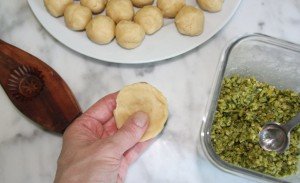


5. Next press the filled dough balls one by one into the ma’amoul mold.
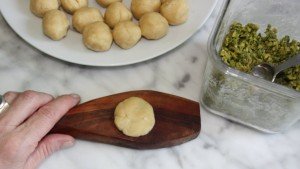
To snap the dough out of the mold, tap the tip of the mold against the edge of the counter with a firm quick movement. With the other hand, catch the ma’amoul and place it on an un-greased cookie sheet. Dust some flour inside the mold if it’s sticking. Don’t worry about imperfections. They will be covered up by the confectioner’s sugar.
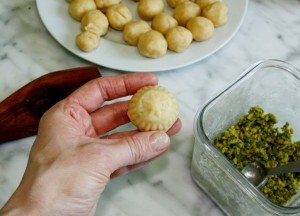
6. If you do not have a mold, flatten the balls slightly and decorate the sides and tops by using a fork.
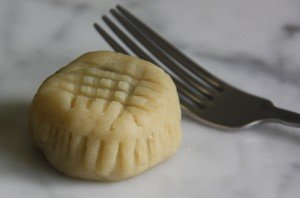
7. Bake in a preheated slow oven (350°F, gas mark 3) for 15 to 20 minutes. (Smaller pastries will require less time.) Baking ma’amoul is a delicate operation and requires constant attention. The bottom-side of the ma’amoul will be slightly browned, but the tops should appear soft and uncooked. If the pastry tops become brown, they will become hard and their taste will be spoiled. Upon cooling, the pastries will become firm.
8. Cool ma’amoul on a cooling rack. When they are cold, dust confectioner’s sugar over them. They keep for at least a week in a tightly closed tin. 
On Eid morning in the Arab world, it’s the custom to go visiting family, neighbors and friends. The host typically offers coffee and pastry, served up with some witty conversation. Some people may visit a dozen homes on Eid, stuffing themselves with coffee, sweets and the latest gossip.
Question: Have you made ma’amoul with nuts? What do you serve on Eid?
 When I heard the premise of this film, I knew I had to see it—a bittersweet comedy about a group of Lebanese women who try to ease the religious tensions between the Christian and Muslim men in their village.
When I heard the premise of this film, I knew I had to see it—a bittersweet comedy about a group of Lebanese women who try to ease the religious tensions between the Christian and Muslim men in their village.
 Follow
Follow











